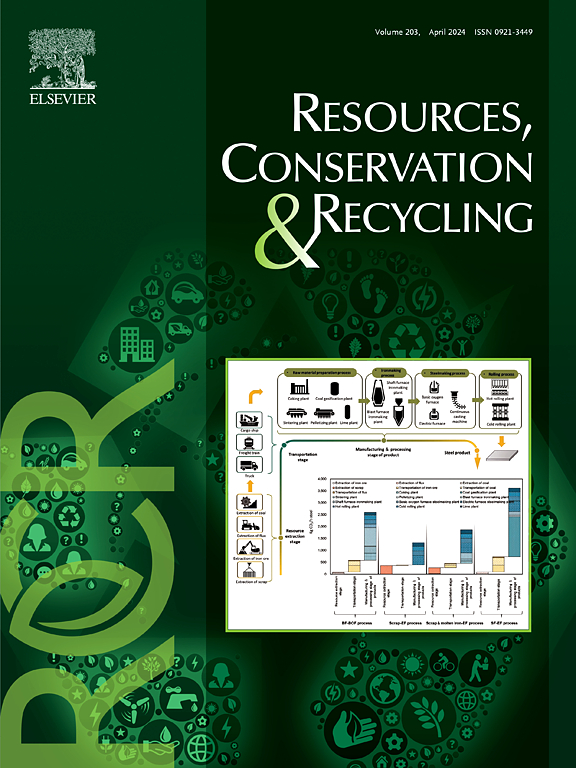A systematic review of PET circularity technologies and management strategies: Challenges and future directions
IF 10.9
1区 环境科学与生态学
Q1 ENGINEERING, ENVIRONMENTAL
引用次数: 0
Abstract
In response to the escalating environmental, economic, and social challenges posed by Polyethylene Terephthalate (PET) waste, the past two decades have witnessed a significant expansion in PET recycling and reuse research. This study conducts a systematic literature review of PET-related research published between 2000 and 2024, utilizing the Web of Science (WoS) Core Collection database's Advanced Search function to retrieve relevant literature. The searching strategy employed predefined inclusion and exclusion criteria to ensure the selection of studies specifically related to PET recycling and reuse, ultimately identifying 4847 key research sources after manual screening. To systematically analyze the selected literature, a bibliometric clustering approach using VOSviewer was applied, revealing four dominant research areas: environmental impacts and economic performance, recycling technologies, waste management, and sector-specific applications. A conceptual framework was developed to synthesize key research trends, methodological approaches, and limitations across these domains.
This study revealed that while PET recycling technologies have advanced significantly, challenges persist in terms of energy efficiency, cost competitiveness, and scalability. Life Cycle Assessment (LCA) studies often overlook the end-of-life phase, limiting the accuracy of environmental impact evaluations, particularly in construction applications. Additionally, economic analyses of PET circularity remain fragmented, often failing to capture regional cost variations, market fluctuations, and the economic feasibility of emerging recycling methods. The study also identifies a lack of spatial-temporal research on PET material flows, limiting the ability to design adaptive and region-specific waste management strategies.
Consequently, several promising research opportunities have been identified: (1) improving end-of-life lifecycle assessments for PET applications, particularly in construction; (2) optimizing chemical recycling methods; (3) enhancing enzyme catalytic efficiency, thermal stability, and scalability; (4) leveraging artificial intelligence (AI) for precise PET sorting and waste flow optimization; (5) developing PET-specific data frameworks that incorporate spatial-temporal dimensions for tracking production, consumption, and recycling trends; (6) integrating informal and formal PET recycling systems in emerging economies; (7) exploring consumer perceptions, trust, and willingness to pay for recycled PET products; and (8) examining the interaction between recycling habits and infrastructure to optimize recycling system adoption and efficiency.
Previous reviews predominately focused on technological advancements, environmental impacts, or specific industries. By contrast, this study adopts an interdisciplinary perspective, integrating insights from materials science, chemical engineering, environmental science, and management studies. While most prior reviews emphasize PET recycling in packaging and textiles, this study extends the scope to construction, where PET reuse remains underexplored. By addressing these gaps, this review provides a more holistic understanding of PET circularity and identifies key research priorities for advancing both theory and practice.
This review provides practical insights for industries and researchers by highlighting key gaps and opportunities for improving PET circularity. The findings can guide technological advancements, enhance waste management efficiency, and drive innovations in PET reuse across different sectors. Additionally, the study underscores the economic potential of PET circularity, offering strategic insights for businesses aiming to develop more cost-effective and sustainable PET recycling processes. By integrating environmental, technological, economic, and behavioral perspectives, this review lays a foundation for more efficient, scalable, and commercially viable PET recycling solutions, ultimately contributing to global sustainability efforts.

PET循环技术与管理策略的系统综述:挑战与未来方向
为了应对聚对苯二甲酸乙二醇酯(PET)废弃物带来的日益严重的环境、经济和社会挑战,在过去的二十年里,PET回收和再利用研究得到了显著的扩展。本研究利用Web of Science (WoS) Core Collection数据库的高级检索功能,对2000 - 2024年间发表的pet相关研究进行了系统的文献综述。搜索策略采用预定义的纳入和排除标准,确保筛选出与PET回收再利用相关的研究,最终通过人工筛选筛选出4847个重点研究来源。为了对选定的文献进行系统分析,使用了VOSviewer的文献计量聚类方法,揭示了四个主要研究领域:环境影响和经济绩效、回收技术、废物管理和部门特定应用。开发了一个概念性框架,以综合这些领域的关键研究趋势、方法方法和局限性。这项研究表明,尽管PET回收技术取得了显著进步,但在能源效率、成本竞争力和可扩展性方面仍然存在挑战。生命周期评价(LCA)研究往往忽略了生命周期结束阶段,限制了环境影响评价的准确性,特别是在建筑应用中。此外,PET循环的经济分析仍然是碎片化的,往往无法捕捉区域成本变化、市场波动和新兴回收方法的经济可行性。该研究还指出,缺乏对PET材料流动的时空研究,限制了设计适应性和区域特定废物管理策略的能力。因此,确定了几个有前途的研究机会:(1)改进PET应用的生命周期结束评估,特别是在建筑领域;(2)优化化工回收方法;(3)提高酶的催化效率、热稳定性和可扩展性;(4)利用人工智能(AI)对PET进行精确分类和废物流优化;(5)开发包含时空维度的pet专用数据框架,用于跟踪生产、消费和回收趋势;(6)整合新兴经济体的非正式和正式PET回收系统;(7)探索消费者对再生PET产品的认知、信任和支付意愿;(8)研究回收习惯与基础设施之间的相互作用,以优化回收系统的采用和效率。以前的评论主要集中在技术进步、环境影响或特定行业。相比之下,本研究采用跨学科的视角,整合了材料科学、化学工程、环境科学和管理研究的见解。虽然大多数先前的评论强调PET在包装和纺织品中的回收利用,但本研究将范围扩展到建筑领域,其中PET的再利用仍未得到充分探索。通过解决这些差距,本综述提供了对PET循环的更全面的理解,并确定了推进理论和实践的关键研究重点。这篇综述通过强调提高PET循环的关键差距和机会,为行业和研究人员提供了实用的见解。研究结果可以指导技术进步,提高废物管理效率,并推动不同部门PET再利用的创新。此外,该研究强调了PET循环的经济潜力,为旨在开发更具成本效益和可持续的PET回收工艺的企业提供了战略见解。通过整合环境、技术、经济和行为方面的观点,本综述为更有效、可扩展和商业上可行的PET回收解决方案奠定了基础,最终为全球可持续发展做出贡献。
本文章由计算机程序翻译,如有差异,请以英文原文为准。
求助全文
约1分钟内获得全文
求助全文
来源期刊

Resources Conservation and Recycling
环境科学-工程:环境
CiteScore
22.90
自引率
6.10%
发文量
625
审稿时长
23 days
期刊介绍:
The journal Resources, Conservation & Recycling welcomes contributions from research, which consider sustainable management and conservation of resources. The journal prioritizes understanding the transformation processes crucial for transitioning toward more sustainable production and consumption systems. It highlights technological, economic, institutional, and policy aspects related to specific resource management practices such as conservation, recycling, and resource substitution, as well as broader strategies like improving resource productivity and restructuring production and consumption patterns.
Contributions may address regional, national, or international scales and can range from individual resources or technologies to entire sectors or systems. Authors are encouraged to explore scientific and methodological issues alongside practical, environmental, and economic implications. However, manuscripts focusing solely on laboratory experiments without discussing their broader implications will not be considered for publication in the journal.
 求助内容:
求助内容: 应助结果提醒方式:
应助结果提醒方式:


